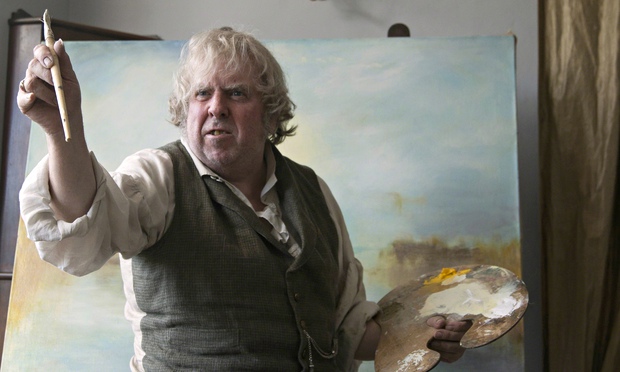Not too long ago, I was in a movie theater when up came a preview for a film called “Mr. Turner,” which would be J.M.W. Tuner to RCA readers. I checked it out and discovered that it was set to open today (Oct. 31) in Britain (after being shown at at Cannes) and in the U.S. on Dec. 19. Early word: it’s good.
 The movie focuses on the last 25 years of Turner’s life, up until his death in 1851. Rated R, it’s described this way:
The movie focuses on the last 25 years of Turner’s life, up until his death in 1851. Rated R, it’s described this way:
Profoundly affected by the death of his father, loved by a housekeeper he takes for granted and occasionally exploits sexually, he forms a close relationship with a seaside landlady with whom he eventually lives incognito in Chelsea, where he dies. Throughout this, he travels, paints, stays with the country aristocracy, visits brothels, is a popular if anarchic member of the Royal Academy of Arts, has himself strapped to the mast of a ship so that he can paint a snowstorm, and is both celebrated and reviled by the public and by royalty.
Turner is played by Timothy Spall; other art world luminaries in it include John Constable (James Fleet), John Ruskin (Joshua McGuire) and Sir John Soane (Nicholas Jones). Here’s the trailer.
I checked the British papers, and the Telegraph gives it 5 stars, saying:
…Leigh’s film is a supremely enjoyable biopic of the English artist known as “the painter of light  Timothy Spall…gives the finest performance of his career to date… beyond the troughfuls of fun tics, Spall makes Turner tenderly and totally human, which has the effect of making his artistic talents seem even more God-given.
And here’s a teaser about the art:
The painting process, though, is very different: Leigh shoots it in a way that it sometimes resembles an occult ritual.
 The Guardian also gives it 5 stars.
…Timothy Spall is JMW Turner! He is the triumphant star of Mike Leigh’s richly and intensely enjoyable study of the great artist’s final years.
…Mr Turner is funny, humane and visually immaculate, hitting its confident stride straight away. It combines domestic intimacy with an epic sweep, and a lyrical gentleness pervades each scene, tragic or comic. Every line, every detail, every minor character, however casual or apparently superfluous, is absolutely necessary.
And he adds:
Since Mr Turner first appeared, the Late Turner exhibition at Tate Britain has established a new context for watching the film, encouraging us to see his later canvases as something other than proto-modernism, or a late Victorian variation on a Romantic theme. Their almost narcotic grandeur is Turner’s own: a transcendental refinement of the natural world, somehow existing in both the age of steam and the medieval world’s cloud of unknowing….
But Andrew Wilton, chairman of the Turner Society and a trustee of the Turner’s House Trust. has quibbles. As a movie, he thinks Mr. Turner is “a deeply moving and beautiful film… but it’s not quite the Turner I know.” He later says:
Spall went to great lengths to get his drawing and painting right, and sort of succeeds. He misses the crucial point, though: that Turner was a miniaturist by temperament. He made innumerable watercolours on a tiny scale, compressing astonishing amounts of topographical and atmospheric detail into them, and the sketchbooks he took with him on tours usually function in the same way. If you look closely at his oil paintings, you find them equally detailed.
Wilton may be right–we can all judge in December–but I do think that’s asking a lot of a movie made for general audiences.
Turner has never been a favorite of mine, but I still want to see this movie and I still hope it bring more people to art.
Photo Credit: Courtesy of AllStar via The Guardian
